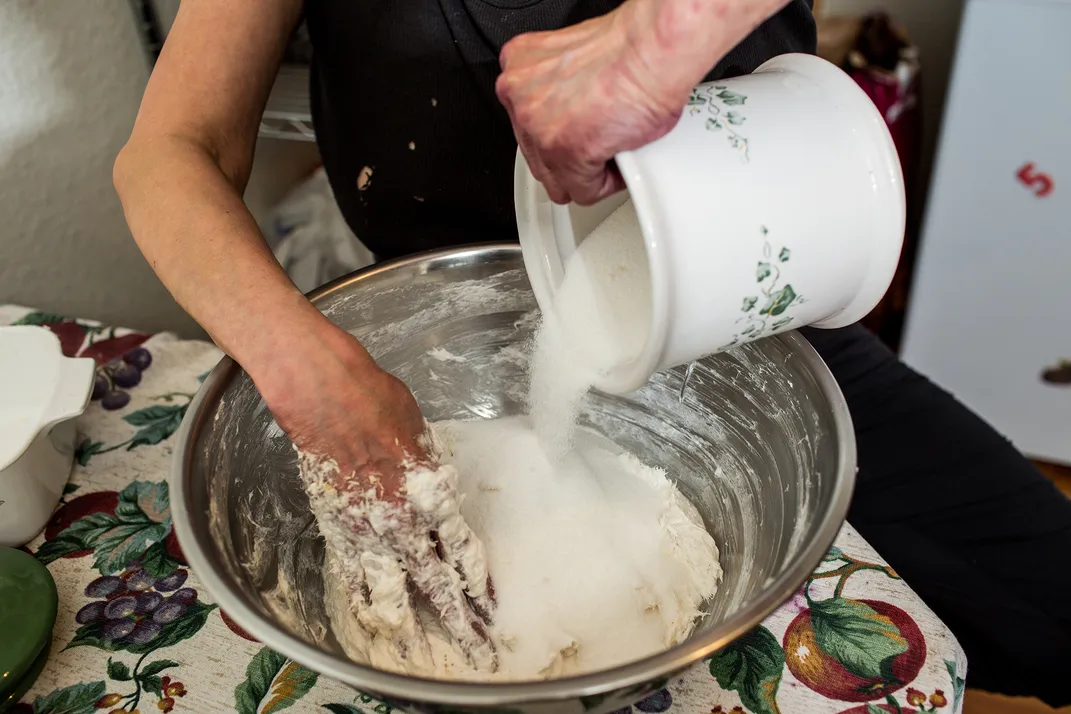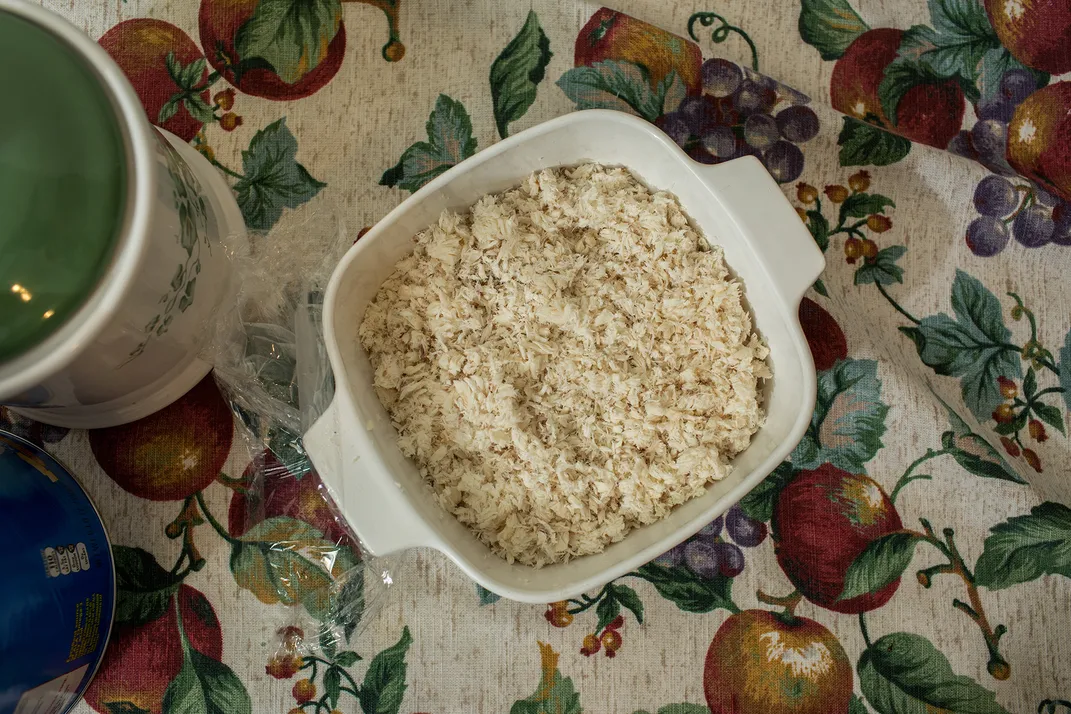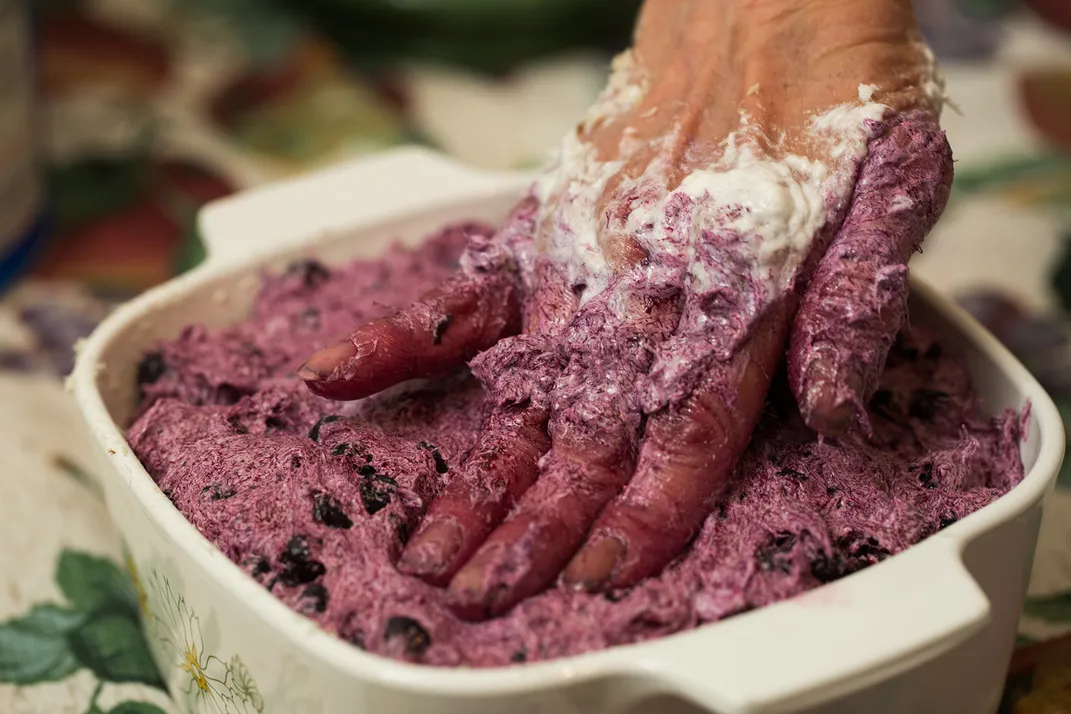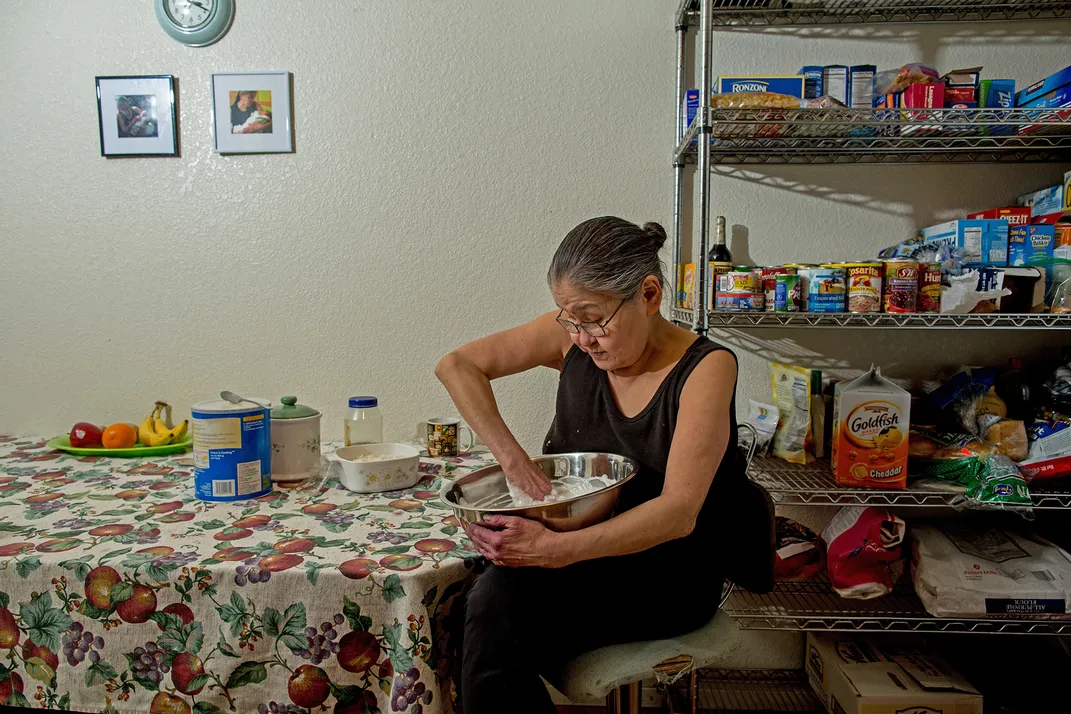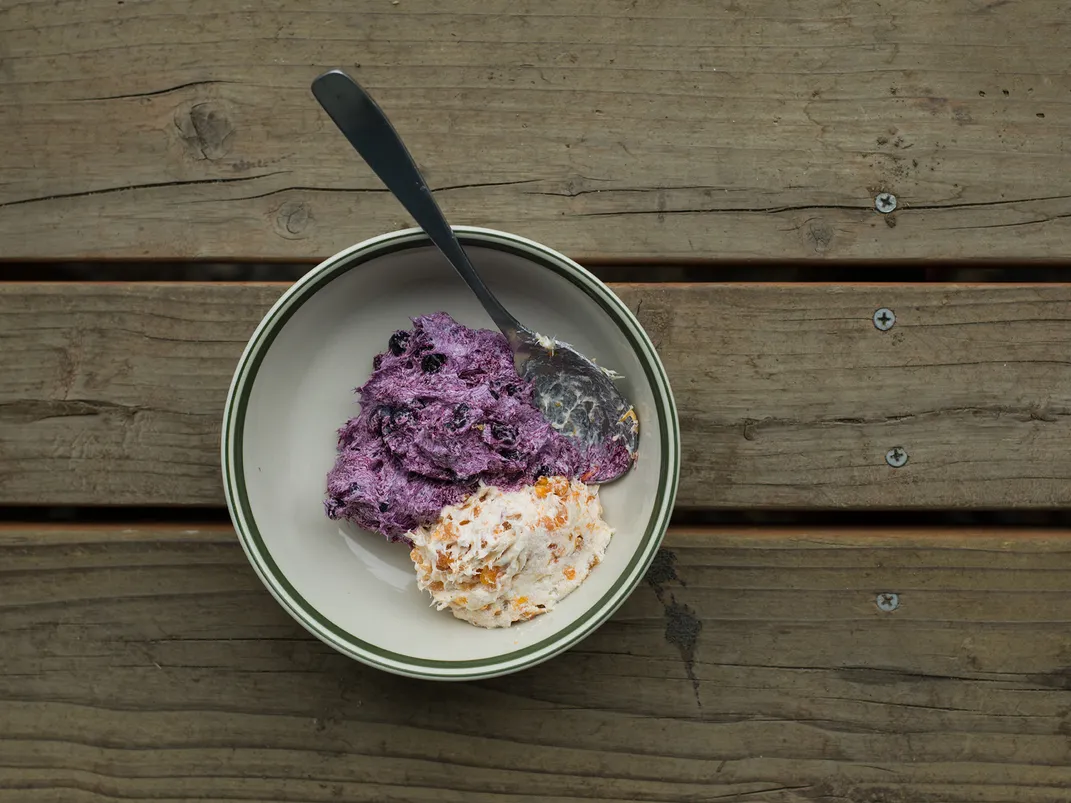What Is Eskimo Ice Cream?
Answer: Not your typical summer dessert
/https://tf-cmsv2-smithsonianmag-media.s3.amazonaws.com/filer/b4/b8/b4b8b1c0-3bbc-44d1-98c9-d87d266eee7d/sqj_1607_alaska_atlas-of-eats_01.jpg)
The first time I tasted akutuq (gutturally pronounced AUK-goo-duck) was out on the ice when I lived above the Arctic Circle. My parents taught school in the small Eskimo village of Shungnak, 150 miles up the Kobuk River, before World War II broke out. At the time, I had no idea that the centuries-old dish was a favorite throughout Alaska, or that it had numerous variations and life-saving qualities. It was simply a treat.
Remote villages then had no electricity, no running water, no sewer system, not even a store. Almost everyone had a dogsled. In our village, a church spire dominated the surrounding clapboard structures. A schoolhouse stood on the highest knoll overlooking the Shungnak River and the mountains beyond. That’s where we lived, on the second floor. My parents taught grades one through eight on the first floor, while my babysitters taught me native games, took me berry picking, and pampered me with native foods.
My favorite jaunt was out on the river to watch men haul fishnets up through the ice, sending whitefish flapping like crazy over the frozen surface. Seeing me, a neighbor named Old Jim would grin widely and yell “akutuq!” as he stooped to pick up a fish. Holding it belly up, he’d bend it until the skin snapped open and eggs popped out onto the ice. Jim would quickly smash the egg membranes with a rock. With splayed fingers he’d stir, faster and faster, pulling little handfuls of snow into the mass. Within ten minutes a cloud-like batch of frozen akutuq would take shape. We devoured it on the spot, scooping up portions with our fingers, savoring each mouthful as it melted over our tongues.
Old Jim’s version of the dish is one of many, and perhaps the most basic. Akutuq means “to stir,” an apt name for a dish that involves whipping animal fats by hand. As recently as a century ago, cooks prepared large batches of akutuq and stashed them in the family’s permafrost cellar until frozen, ready for everyday meals or drop-in guests. Nowadays, it’s often whipped until the volume increases six times, and crafted into a fluffy and festive dessert. Outsiders call it Eskimo ice cream, as much for its appearance as for its texture and taste.
Akutuq’s ingredients vary widely. The classic northern Alaskan ingredients include hard fat (caribou, bear, muskox), sea-mammal oil (seal, whale), and a flavoring (from either flora or fauna). Elsewhere in the state, cooks adapted their recipes to local food sources. Caribou and freshwater fish flourish inland. Saltwater fish and seal inhabit coastal areas. Below Anchorage, in Southwest Alaska, native cooks use eulachon, better known as candlefish, mixed with oil and snow. Unlike the sturdy affair made with caribou fat by northern Inupiaq Eskimo women, the dish has a short life. Within minutes it collapses into a puddle.
Just before World War II was declared, my family moved to Oregon, hoping to find safer ground. But those childhood food memories always stayed with me. Without really knowing why, I studied sociology and anthropology in college, then apprenticed as a chef before running a cooking school for three decades. Those disciplines primed me for my inevitable return home, helping me understand the history and other intricacies of Arctic food.
By the time I returned to Alaska in 1995, most outlying villages had electricity and running water. Snowmobiles, four-wheelers, and pickup trucks were everywhere. Every village had a store with canned goods sitting sparsely on the shelves. A small cooler, often empty, was reserved for vegetables.
Along parts of the Seward Peninsula, empty seal-drying racks stood like ghostly sentinels by the water’s edge. Instead of 20 busy camps, no more than four were active, and the workers there were elders. Young women preferred office jobs, teaching, or medical positions—not the traditional day-to-day backbreaking work of flensing blubber from ugruk (bearded seal) skins, which supplied seal oil, an essential ingredient in the Arctic diet. The cuisine was threatened—the culture, too.
Since I was trained as a social scientist and a chef during my half century Outside, I wanted to know how food shaped the lives of Inupiaq women. I had in mind the old adage: “When an elder dies, a library burns.” So I sought out elders who would impart their knowledge of history and traditional cooking techniques. Luckily, I met Esther, a noted Inupiaq cook originally from the ancient coastal village of Wales, on the Seward Peninsula. When she invited me to stay at her fish camp, I eagerly accepted. Over the next 15 years she taught me the Eskimo way of subsistence food preparation, simply by doing it.
One July afternoon I witnessed a seal-oil leak—a horror to those who struggle to gather and prepare food from the wild. A gallon of oil had oozed from a tiny hole in a plastic container onto the plywood floor of the makeshift rendering room, a waste of untold hours of work and the loss of an important seasoning; like salt and pepper for Outsiders, seal oil is used to enhance almost all native foods. “Worse than the Valdez spill,” Esther’s sister, with tears in her eyes, joked about the precious loss, hoping laughter would soften the hurt. That’s when Esther, perhaps hoping to buck up everyone’s spirits, said, “We’ll make akutuq tomorrow.”
Sitting on her kitchen floor the next day, Esther assembled caribou fat and seal oil for the family’s favored dessert. Using ratios from centuries-old recipes—the same fundamental measuring system taught in modern culinary schools—she apportioned the ingredients: one part hard fat, one part seal oil, one part water, and four parts plant or protein material.
Akutuq is a simple dish, but simple dishes are frequently the most difficult to produce. Every step requires precise execution. Ingredients are not easily obtained. Male hunters are needed to kill caribou. Women are needed to flense and meticulously remove blood and meat from the blubber, which is stored, ideally at 50° Fahrenheit, away from the sun and heat to prevent spoiling. As the fatty chunks sit in wooden or plastic containers, the polyunsaturated oil seeps from the blubber. When rendered properly—without blood or fat—the oil resembles an oaked chardonnay wine: golden and clear.
For akutuq, Esther prefers the white visceral fat surrounding the caribou’s small intestines. After cutting it into tiny pieces, she smashes it, softening and warming it with her fingers. A century ago, women hurried the process by chewing the fat, but the method imparted an unpleasant tobacco taste to the dish if the cook was a pipe smoker. Esther discarded all sinew and tiny lumps, then quickly stirred the fat with splayed fingers until it became white, smooth, and tripled in volume. She added seal oil, a tablespoon at a time, then a little water to increase the fluffiness. After 45 minutes the mix looked like a shiny white frosting ready to cover a cake. In went salmonberries and blueberries—and a little sugar, an ingredient the whalers introduced in the mid-1800s. The flavor was delicate, slightly sweet, and rich with fruit. The texture was smooth and silky, with the sensuous feel of a French buttercream. Leftovers went into the freezer.
As Esther added berries to the akutuq, she explained that substituting dried meat for the fruit produces a dense, high-fat, protein-rich dish that sustains men during long hunting trips in freezing temperatures. Cooks melted fat and bone tallow in hot water, then cooled it, stirred it, and added the meat. The result was coarse and heavy—similar to a French country pâté. Once frozen, the high-energy mix was (and still is) cut into power-bar-size pemmican. Taking their lead from Arctic hunters, Admiral Peary and Dr. Frederick Cook used the same high-fat provisions when they trekked to the North Pole. A few years later the 1912 Australasian Antarctic Expedition did the same.
When did akutuq originate? No one knows. It might have come across Beringia when man first set foot on North American soil. Without a written language, Inupiaq Eskimos passed their history and customs to children through actions and stories—stories told during days that were as dark as nights. Years were irrelevant. Learning how to survive was the lesson.
Obtaining traditional northern akutuq ingredients has never been easy. For centuries until the early 1900s, Inupiaq and Yup’ik Eskimos traveled up to 600 miles by foot, boat, and dogsled to attend trade fairs on the coast or at the confluences of rivers, hoping to exchange seal oil for caribou fat and vice versa. Food played a huge part in the yearly trade fairs, economically and socially.
During an 1842 gathering along the Yukon River, an akutuq cooking contest took place. While wives frantically stirred their dishes, husbands shouted, pressing their spouses to create new, inventive recipes. Blood, beaver, otter, caribou-stomach contents, dried fish, fish eggs, bird eggs, and berries went into the mix—the more bizarre the better.
Though akutuq is loved by Alaska Natives, fewer and fewer women prepare the dish. In 2007 I was attending an elders conference in Nome, where classes were organized to teach traditional customs to high school students. The akutuq session caught my interest. Not one student attended, but 40 older women sat in rapt attention. When the leader asked, “Who knows how to make akutuq?” my arm was the only one in the air. The previous year I had prepared akutuq for 200 people attending a memorial service. But I cheated. I used a heavy-duty electric mixer—and prayed that Esther wouldn’t hear about my secret shortcut.
Modernity has impacted all of Alaska. The cultural stabilizer for Alaska Natives, especially in far-flung northern villages, has been food. Yet concern is growing that as young people develop an appetite for Outsiders’ food, they might eventually forget their traditional dishes.
Many schoolteachers and residents from the southwest, in hopes of keeping ancient customs alive, prepare the cherished dish of Alaska Natives for their children and students. They modernize it, of course, using Crisco and olive oil, and blending the ingredients with an electric mixer. Children love the abundant berry and sugar additions. They adore the silky, fluffy texture. Little else about the dish smacks of tradition. Yet the exercise is more than a culinary treat. It establishes a link to the past, inspires a sense of pride and belonging, and spurs a dialogue about an ancient people’s remarkable ability to survive.
